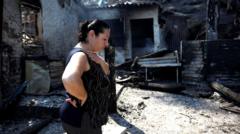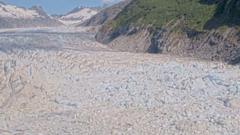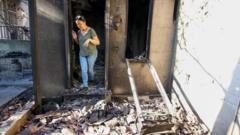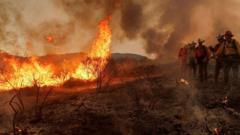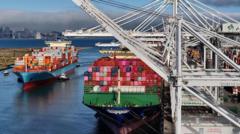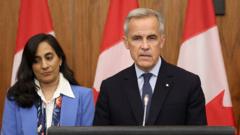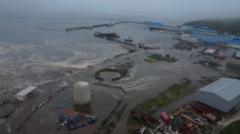Eastern Canada is currently grappling with one of the most devastating wildfire seasons on record, as thousands are evacuated and more stay alert. Over 700 wildfires are blazing across the region, with 18.5 million acres already burned this year, marking a significant threat to communities and ecosystems alike.
Canada's 2025 Wildfire Season Declared Among Worst in History

Canada's 2025 Wildfire Season Declared Among Worst in History
More than 700 active wildfires prompt evacuation orders across Eastern Canada, raising alarms as dry conditions worsen.
Mandatory evacuation orders were put in place for various communities in Newfoundland and Labrador, where five wildfires remain classified as out of control. According to the Canadian Interagency Forest Fire Center, this year has seen a surge in large wildfires, particularly in regions that typically experience smaller wildfire events. Historical data indicates that while fewer acres have burned compared to the catastrophic 2023 season, concerns linger as the wildfire season is expected to continue into September or October.
The fierce fire season has been largely attributed to prolonged hot and dry weather across the country. Many areas are experiencing drought, compounded by insufficient winter snowpack that usually supports moisture levels into spring. This combination has left vegetation highly susceptible to ignition. The western provinces, particularly Saskatchewan and Manitoba, have faced the brunt of the wildfires, with the Shoe fire in Saskatchewan spanning 1.4 million acres—larger than the Grand Canyon.
In recent days, a welcome shift in weather brought rain to Saskatchewan and Manitoba, helping to mitigate conditions that lead to the rapid spread of wildfires. Authorities remain cautious, as the situation has now redirected attention to Newfoundland and Labrador. Less typical for wildfires, these eastern regions are encountering fires amidst dry conditions.
Research scientists stress that many of the fires are located in the wildland-urban interface—where urban developments meet flammable vegetation, heightening the risk for surrounding communities. Amidst the rising danger, a state of emergency has been declared in Newfoundland and Labrador. The government has issued heat warnings and enforced restrictions on outdoor burning and the use of off-road vehicles in forested regions to prevent exacerbating the situation.
While Quebec has seen a moderate wildfire season, benefiting from increased rainfall earlier in the year, the overall struggle continues. Premier John Hogan of Newfoundland and Labrador indicated that existing fires have grown due to alarming temperatures and gusty winds, accentuating the state's precautionary measures against fire-related activities.
As Canada faces this intense wildfire season, the situation serves as a poignant reminder of the urgent challenges posed by climate change and its impact on natural disasters.
The fierce fire season has been largely attributed to prolonged hot and dry weather across the country. Many areas are experiencing drought, compounded by insufficient winter snowpack that usually supports moisture levels into spring. This combination has left vegetation highly susceptible to ignition. The western provinces, particularly Saskatchewan and Manitoba, have faced the brunt of the wildfires, with the Shoe fire in Saskatchewan spanning 1.4 million acres—larger than the Grand Canyon.
In recent days, a welcome shift in weather brought rain to Saskatchewan and Manitoba, helping to mitigate conditions that lead to the rapid spread of wildfires. Authorities remain cautious, as the situation has now redirected attention to Newfoundland and Labrador. Less typical for wildfires, these eastern regions are encountering fires amidst dry conditions.
Research scientists stress that many of the fires are located in the wildland-urban interface—where urban developments meet flammable vegetation, heightening the risk for surrounding communities. Amidst the rising danger, a state of emergency has been declared in Newfoundland and Labrador. The government has issued heat warnings and enforced restrictions on outdoor burning and the use of off-road vehicles in forested regions to prevent exacerbating the situation.
While Quebec has seen a moderate wildfire season, benefiting from increased rainfall earlier in the year, the overall struggle continues. Premier John Hogan of Newfoundland and Labrador indicated that existing fires have grown due to alarming temperatures and gusty winds, accentuating the state's precautionary measures against fire-related activities.
As Canada faces this intense wildfire season, the situation serves as a poignant reminder of the urgent challenges posed by climate change and its impact on natural disasters.


